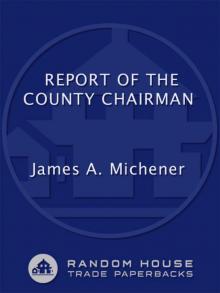- Home
- James A. Michener
Creatures of the Kingdom: Stories of Animals and Nature
Creatures of the Kingdom: Stories of Animals and Nature Read online
2014 Dial Press Trade Paperback Edition
Copyright © 1993 by James A. Michener
Excerpt from Centennial copyright © 1974 by James A. Michener
Illustrations copyright © 1993 by Karen Jacobsen
All rights reserved.
Published in the United States by Dial Press Trade Paperbacks, an imprint of Random House, a division of Random House LLC, a Penguin Random House Company, New York.
DIAL PRESS and the HOUSE colophon are registered trademarks of Random House LLC.
Originally published in hardcover in the United States by Random House, an imprint and division of Random House LLC, in 1993.
eBook ISBN 978-0-8041-5137-5
Portions of this work were originally published in Alaska, Centennial, Chesapeake, The Covenant, Hawaii, and Texas, all by James A. Michener.
www.dialpress.com
v3.1_r1
CONTENTS
Cover
Title Page
Copyright
Foreword
FROM THE BOUNDLESS DEEP (from Hawaii)
THE BIRTH OF THE ROCKIES (from Centennial)
DIPLODOCUS, THE DINOSAUR (from Centennial)
A MIRACLE OF EVOLUTION (from Centennial)
THE MASTODON (from Alaska)
MATRIARCH, THE WOOLLY MAMMOTH (from Alaska)
PORTRAIT OF RUFOUS (from Centennial)
THE BEAVER (from Centennial)
THE EAGLE AND THE SNAKE EPILOGUE: THE DEATH OF ELLY ZAHM (from Centennial)
THE HYENA (from The Covenant)
NERKA THE SALMON (from Alaska)
ONK-OR (from Chesapeake)
THE INVADERS (from Texas)
JIMMY THE CRAB (from Chesapeake)
LUCIFER AND HEY-YOU (from Chesapeake)
THE COLONEL AND GENGHIS KHAN (with An Introductory Note)
Dedication
Other Books by This Author
About the Author
Excerpt from Centennial
FOREWORD
When I try to locate myself in the scheme of things I discover that I am a rather puny member of the animal kingdom—weight 166 pounds, while an elephant weighs two tons, a gorilla 880 pounds—living in a small town (Doylestown 8,717 population—Shanghai 11 million, Calcutta 9 million), in a small state (Pennsylvania 45,333 square miles—Alaska 569,600, Texas 267,338) in a relatively small nation (United States 3,618,770 square miles—Russia 8,649,490, Canada 4,014,263) in one of the smaller continents (North America 9.3 million square miles—Asia 17, Africa 11.7) on quite a small planet (if Earth is given the index 1, Jupiter is 1403, Saturn 832), attached to a sun that is only an average star (millions of other stars are bigger and brighter), off to the edge of one of the smaller galaxies (it has only 400 billion stars, while most of the other 100 billion galaxies appear to be larger, sometimes massively so).
I cannot, therefore, ever think of myself as exceptional in any respect. I know that man could never have survived the violent volcanic upheavals in the Pacific Ocean that created the glorious chain of Hawaiian islands. The first tenants of the newly born Rocky Mountains surely did not walk upright. My kind has lived here on Earth only a few million years; the dinosaurs thrived for a hundred million. And I am not homocentric enough to think that man embodies all that is best in the animal kingdom, in which he plays a dominant part. He cannot slither along on his belly like a snake or use his nose to feed himself the way an elephant can. He has not the incredible hearing system of a bat, the sense of smell of a bloodhound, or the capacity to survive underwater like a slug. He cannot cast off his aging skin like a crab or stand motionless for hours on one foot like a blue heron. Man is a wonderful creature, majestic in his mental capabilities, but in many other respects he is either limited or downright deficient.
If man assesses himself honestly when he compares himself with the other animals, he can avoid getting a swelled head. The great reward of making such a comparison is the discovery of a vital truth: since man shares this earth with other creatures, he is morally obligated to treat them as members of his own family.
It is hideous to terminate a natural species, especially when one contemplates the millions of years it may have taken for that creature to evolve from a prehistoric prototype. The fact is that once a species, whether flora or fauna, has been killed off, it is lost forever. The primordial conditions that either allowed or encouraged it to evolve are now gone. There is no longer any seminal ooze in which various life forms can thrive and develop; there are no vast, permanent swamps on whose shores they can climb or take root to make their way to transforming themselves. The temperatures of oceans have cooled, the chemical components altered. It may be technologically impossible for a reptile to evolve into a bird the way the pterodactyl presumably did. The conditions of place and time are not right.
There is, of course, a radical possibility. Astronomers seem to agree that the earth has about four billion more years of existence and during that time it is possible that some cataclysm of the kind that may have altered history in the past could recur to wipe out man and allow a new creation to repeat instantly. (I do not believe or accept that speculation; I believe that genesis will come about in an orderly, continuous way in obedience to the definable laws of nature.) Within the span of man’s custodianship, which has been brief, of natural treasures like water, forests and clean air, we must do our best to protect and preserve all that exists.
I feel pain in my heart when I study the latest reports on species that are in danger of total extinction. Picture these magnificent animals tramping through the bush or plodding their way over desert sands: the tiger, the gorilla, the giant panda, the elephant, the Bactrian camel, to name only a few. That is a catalog of majesty, a treasury of great images, an evocation of how diverse and powerful and noble nature can be when creatures are allowed to undergo eight or ten million years of evolution. Ten million years from now, our elephant could possibly become something even more wonderful, if we do not terminate the process now.
I am reminded of something in a lighthearted vein—a cartoon that appeared some years ago, in what magazine I do not remember. It showed two imaginary creatures climbing ashore out of the primordial ooze, one male, one female, obviously intent on a common purpose. But they are both distressed and frustrated, for planted on the sand dune they had hoped to use is a handsomely lettered sign, such as one sees on military bases, that says NO EVOLVING.
I am not an impartial witness to developments in the animal kingdom. I love animals, have always lived with them, have tried to understand them, and have written about them with affection in an effort to remind others of what a significant enrichment to human life they can be. This anthology of some of the many passages I have written about various animals testifies to that abiding love.
I’ve had warm relationships with many kinds of animals. I have a photograph that shows Java, one of the gentlest, most caring dogs my wife and I ever had, hovering nearby to protect me, if need be, from the strange woman who was photographing us—Java is in the foreground, where she always tried to be if anything seemed to threaten me. In Maryland two stately blue herons took residence in a swamp behind our house, standing silent hour after hour as they waited for fish to swim by. Victor and Victoria, my wife named them, and they became members of our family, communicating with us, waiting for fish scraps, guarding our house.
A family of bluebirds nested six inches from my study window and grew to ignore my typing. I lost a running battle with a squirrel who believed that the sunflower seeds I put out for the cardinals and evening grosbeaks were intended for him. Once, for several days in t
he Brazilian wilderness along the banks of the Amazon, I became familiar with a monstrous boa constrictor, tamed by others, who climbed about my arms and shoulders.
But the wild animals I remember best among the buffalo, the Kodiak bears, the bald eagles and the salmon I have studied were two hyenas, one in southern Spain and one on the Serengeti Plain in central Africa. The latter frequented a tourist camp—a kind of motel in the savannah—where he made himself a beloved pet. Lurching about, grinning in his hideous way at his friends, growling when necessary, he became passionately addicted to bottled beer, and we used to watch as he wandered from one bar table to the next, neatly reaching for half-filled bottles and chug-a-lugging their contents. Toward sundown he would stagger off to find someplace to sleep it off, and when the tourists who’d been out on the veldt watching the hordes of animals returned to their cottages, we always knew where our hyena was, for we would hear screams, indicating that some traveler from London or Berlin or San Francisco had found the hyena asleep on his or her pillow.
My relations with the hyena in Spain were of a more personal character. A famed Spanish naturalist had brought home to the Cádiz area a female hyena that he had more or less tamed. Tied to a tree with a chain so long that she could roam about, she was always delighted to see me because she knew that I would rough-house with her. As we wrestled, I punched her rather forcefully while she nipped at my ankles and wrists. But always the time came when she would take my forearm in her powerful jaws, tighten her teeth with increasing power, as if to say: If I wanted to, Buster, I could bite your arm in half. Then she would release me, throw her powerful arms around me and hug me for the sheer joy of companionship. I had the same relationship with a semi-tamed boa constrictor in the Amazon. He, too, could have crushed me had he wanted to, but he, too, enjoyed rough play.
It was on the Serengeti that I had my most extraordinary experience with animals. John Allen, the English protector of the great herds that passed through and a man who cherished his relationship with animals, took me first on a low-flying plane trip over a large portion of the Serengeti to show me the elephants, giraffes and water buffaloes, but it was when he landed near a hillock so that we could have a picnic that I saw African wildlife at its most awesome: coming straight at us was a mixed herd of at least five hundred thousand wildebeests and zebras on their way to new feeding grounds.
John, one of his assistants armed with a powerful rifle, my wife and I walked out among the animals and in time found ourselves deep in the midst of this enormous migration. It was eerie. Slowly, the animals came directly at us, but when they reached a spot about ten yards from us they mysteriously parted, half to the left, half to the right, leaving us in a lozenge-shaped free zone; as soon as they passed, they closed ranks again, heading purposefully for their feeding grounds. I tried several times to touch the passing animals, but, without ever seeming to look at me, they maintained that ten-yard distance and rushed past. It was an experience few have had, being in the dead center of a vast herd on the move.
But the part I recall most often is what happened as we returned to our car. Our path took us past the wooded hillock we had used as a guide point, and as we approached it, John Allen moved my wife and me to the inside nearest the copse, while he and his armed assistant unlimbered their guns and walked well to our right, away from the scrub. When we were safely past I asked: ‘What was that all about?’ and Allen explained: ‘Lions infest those woods, and sometimes they leap out to grab unwary travelers. Tom and I had to stand back so that if the lion leaped at you we had free range to shoot him dead before he got you.’
I asked: ‘Do you ever miss? Or does the gun ever fail to shoot?’ and he said reassuringly: ‘It’s our business to see it doesn’t.’ Not many novelists in their seventies have been used as lion bait.
These excerpts from my various books depict the way I think and feel about animals. Each segment was an integral part of the novel in which it appeared, just as animals have been an integral part of my life. The animals entered my pages as naturally as they occupied the veldt or the ice cap or any other habitat.
Those of us who love animals and try to write about them accurately are often, and sometimes with reason, charged with the literary sin of the ‘pathetic fallacy,’ which the dictionary defines as ‘the attribution of human emotions or characteristics to things or animals; e.g., angry hurricane, vengeful cobra.’ Purists who object to such usage can be vehement in their objections, and, probably, rightly so. The hurricane that is born off the West African coast, gathering power as it whips westward across the Atlantic, is not angry at the island of St. Croix. But if you are on St. Croix when the hurricane hits, you can be forgiven for thinking that the storm is venting its anger.
I have tried, not always successfully, to avoid the pathetic fallacy when dealing with animals, but if some purist denies that the drunken hyena in the Serengeti lodge had a self-satisfied smirk on his face as he lurched off to bed, or that my dog Java evidenced a protective love for me, I cannot accept his or her censure.
I have often been asked whether I have allowed my personal life or characteristics to appear in my novels. The answer is ‘Yes, the old buffalo Rufous in Centennial comes close to a self-portrait.’ While researching that work I paid prolonged visits to a ranch that supported a small herd of bison, and as I studied them, imagining a time when millions roamed the western plains, I began to identify with a grizzled fellow who remained more or less off to one side as if he were contemplating the fate of his herd. (Talk about the pathetic fallacy!) At the conclusion of my visits, when I had to turn to other subjects, I felt as if I understood the old geezer and, reluctant to leave him, I put him in my book. I am pleased and touched when readers tell me that they too grew to like him.
—JAMES A. MICHENER
Eckerd College
28 January 1991
FROM THE BOUNDLESS DEEP
Millions upon millions of years ago, when the continents were already formed and the principal features of the earth had been fixed, there was, then as now, one aspect of the world that dwarfed all others. It was a mighty ocean, lying to the east of the largest continent, a restless, ever-changing, gigantic body of water that would later be described as pacific.
Over its brooding surface immense winds swept back and forth, whipping the waters into towering waves that crashed down upon the world’s seacoasts, tearing away rocks and eroding the land. In its dark bosom, strange life was beginning to form, minute at first, then gradually of a structure now lost even to memory. Upon its farthest reaches birds with enormous wings came to rest, and then flew on.
Agitated by a moon stronger then than now, immense tides ripped across this tremendous ocean, keeping it in a state of torment. Since no great amounts of sand had yet been created, the waters where they reached shore were universally dark, black as night.
Scores of millions of years before man rose from the shores of the ocean to perceive its grandeur and to venture forth upon its turbulent waves, this eternal sea existed, larger than any other of the earth’s features, more enormous than the sister oceans combined, wild, terrifying in its immensity and imperative in its universal role.
How utterly vast it was! How its surges modified the very balance of the earth! How completely lonely it was, hidden in the darkness of the night or burning in the dazzling power of a sun younger than ours.
At recurring intervals the ocean grew cold. Ice piled up along its extremities and pulled vast amounts of water from the sea, so that the wandering shoreline of the continents sometimes jutted miles farther out than before. Then, for a hundred thousand years, the ceaselessly turbulent ocean would tear at the exposed shelf of the continents, grinding rocks into sand and incubating new life.
Later the fantastic accumulations of ice would melt, setting cold waters free to join the heaving ocean, and the coasts of the continents would lie submerged. Now the restless energy of the sea deposited upon the ocean bed layers of silt and skeletons and salt. For a million
years the ocean would build soil, and then the ice would return; the waters would draw away; and the land would lie exposed. Winds from the north and the south would howl across the empty seas and lash stupendous waves upon the shattering shore. Thus the ocean continued its alternate building and tearing down.
Master of life, guardian of the shorelines, regulator of temperatures and sculptor of mountains—the great ocean was all these.
Millions upon millions of years before man appeared on Earth, the central areas of this tremendous ocean were empty, and where famous islands now exist nothing rose above the rolling waves. Of course, crude forms of life sometimes moved through the deep, but for the most part the central ocean was marked only by enormous waves that moved at the command of moon and wind. Dark, dark, they swept the surface of the empty sea, falling only upon themselves, terrible and lonely and puissant.
Then one day millions of years ago, a rupture developed in the rocky bed of the ocean. It occurred near the middle of the sea, a bit closer to what would later become the western United States than to the shores of eastern Asia. Some great fracture of the earth’s basic structure had occurred, and from it began to ooze a white-hot liquid rock. As it escaped from its internal prison and came into contact with the ocean’s wet and heavy body, the rock instantly exploded, sending aloft through the nineteen thousand feet of ocean that had pressed down upon it columns of released steam.
Upward, upward, for nearly four miles they climbed, those agitated bubbles, until at last upon the surface of the sea they broke loose and formed a cloud. In that instant the ocean signaled that a new island was building. In time it might grow to become an infinitesimal speck of land that would mark the great central void. No human beings then existed to celebrate the event. Perhaps some weird and now-extinct flying thing spied the escaping steam and swooped down to inspect it; more likely the roots of this future island were born in darkness and brooding nothingness.

 Mexico
Mexico The World Is My Home: A Memoir
The World Is My Home: A Memoir Sayonara
Sayonara Chesapeake
Chesapeake The Novel
The Novel Rascals in Paradise
Rascals in Paradise Return to Paradise
Return to Paradise Presidential Lottery: The Reckless Gamble in Our Electoral System
Presidential Lottery: The Reckless Gamble in Our Electoral System The Source
The Source Poland
Poland Space
Space Caravans
Caravans Creatures of the Kingdom: Stories of Animals and Nature
Creatures of the Kingdom: Stories of Animals and Nature Iberia
Iberia Hawaii
Hawaii The Watermen: Selections From Chesapeake
The Watermen: Selections From Chesapeake Report of the County Chairman
Report of the County Chairman The Covenant
The Covenant The Bridges at Toko-ri
The Bridges at Toko-ri Matecumbe
Matecumbe Journey: A Novel
Journey: A Novel Centennial
Centennial Sports in America
Sports in America Texas
Texas Miracle in Seville
Miracle in Seville This Noble Land: My Vision for America
This Noble Land: My Vision for America Tales of the South Pacific
Tales of the South Pacific Bridges at Toko-Ri
Bridges at Toko-Ri Space: A Novel
Space: A Novel Presidential Lottery
Presidential Lottery Sayonara: A Novel
Sayonara: A Novel This Noble Land
This Noble Land The Covenant: A Novel
The Covenant: A Novel Miracle in Seville: A Novel
Miracle in Seville: A Novel The Bridge at Andau
The Bridge at Andau Source
Source The Source: A Novel
The Source: A Novel Journey
Journey Recessional: A Novel
Recessional: A Novel Legacy: A Novel
Legacy: A Novel The Bridges at Toko-Ri: A Novel
The Bridges at Toko-Ri: A Novel Poland: A Novel
Poland: A Novel